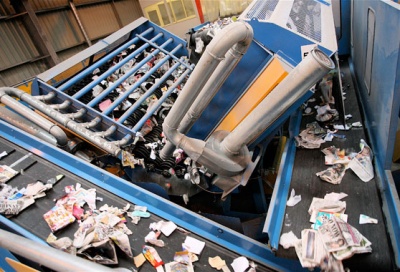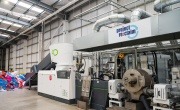Industry concern at MRFs not meeting sampling requirements
 The second set of quarterly reporting data from material recovery facilities (MRFs) since new obligations were introduced has shown that an average of 86.8 per cent of material going into facilities in England is target material, with 7.7 per cent non-recyclable.
The second set of quarterly reporting data from material recovery facilities (MRFs) since new obligations were introduced has shown that an average of 86.8 per cent of material going into facilities in England is target material, with 7.7 per cent non-recyclable.
The data, published by the Waste & Resources Action Programme (WRAP) covers the period of January to March 2015. The results of which have prompted concern about the relatively low number of facilities reporting their data.
The ‘Environmental Permitting (England and Wales) (Amendment) Regulations 2014’ require qualifying materials MRFs to provide quarterly details of the mixed waste tonnage received from each supplier and output tonnage for defined material streams.
MRFs are also required to take samples of the input and output material so that the average percentage of target, non-target and non-recyclable material can be estimated.
To qualify for the regulations, an MRF must receive 1,000 tonnes or more of mixed waste material for sorting in four consecutive reporting periods. This covers around 160 MRFs in England and Wales, but for the second quarter running a large proportion failed to submit data. Responses were received from 85 facilities in England and seven in Wales, both one fewer than in the fourth quarter of 2014.
WRAP warns that any observations of the data should at this point be general, as the process is still new to MRFs, with data quality ‘expected to improve over coming quarters’.
England
Waste supplied to the 85 responding MRFs in England was attributed directly to 219 local authorities (LAs) and 282 other suppliers. Data supplied for the fourth quarter of 2014, the first to be reported under the regulations, only covered 195 LAs and 168 other suppliers.
The total tonnage of material entering the MRFs in Q1 was 876,744, an increase of 87,349 tonnes (11 per cent) from the last quarter. 86.8 per cent of this weight comprised target material (the previous quarter registered 86.6 per cent).
As with the previous quarter, paper made up a large percentage of material received, providing 48.4 per cent of the weight (51.7 per cent in Q4 2014), glass made up 16.9 per cent (15.9), plastics 14.6 per cent (12.9) and metals 6.6 per cent (5.9).
The 636,694 tonnes of output materials from the English MRFs constituted an increase of 56,787 on the Q4 2014 figure.
This means that from the MRFs supplying data in this quarter, there is a difference of 240,050 tonnes between input and output reported in the WRAP portal, amounting to 27.3 per cent of material unaccounted for.
When reporting output, each MRF submitted data for each particular grade of Specified Output Material (SOM). The Q1 data shows that, like in the previous quarter, paper was the least variable material among the MRFs, with an inter-quartile range of 96 to 99 per cent targeted material. Likewise, plastic was again the most variable, returning an interquartile range of 89.8 to 95.8 per cent.
Wales
In Wales the total input tonnage from the seven responding MRFs reached 74,473 tonnes, an 18 per cent increase on the last quarter’s total of 63,128 tonnes. The average percentage of target material decreased slightly from Q4 2014’s figure of 90.6 per cent to 88.3 per cent.
Like England, there was very little variation in the composition of the materials making up the total tonnage. Paper made up the majority with 55.5 per cent (56.3 in Q4 2014), glass was 17.9 per cent (18.0), plastics 9.7 per cent (10.7) and metals 5.1 per cent (5.1).
There was a much smaller difference in the outputs of Welsh MRFs between the two quarters. In Q1 the data shows a total tonnage of 60,439 tonnes, just 3,196 (5.6 per cent) higher than the previous quarter’s total of 57,243 tonnes.
Due to the smaller number of samples, inter-quartile ranges are not published for Welsh outputs but like in England paper recorded the highest average rate of targeted material (97.3 per cent), the glass the lowest (85.7 per cent). Plastic recorded 94.9 per cent and metal 90.6 per cent.
Concern over low number of responding MRFs
Ray Georgeson, Chief Executive of the Resource Association, noted that the practice of reporting is too new to draw any grand conclusions, but again expressed concern at the number of MRFs submitting their data.
He commented: "Our main concern at this stage is not to try and over analyse any trends or patterns in the data, as we think it is still too early.
“We express a continuing concern about the low levels of compliance in terms of data submission with data coming from only 85 MRFs with many more failing to comply with the legislation.
“The failure of a significant part of the industry to move into compliance runs the risk of seriously undermining the value of the Regulations even at this early stage - urgent action is needed by the regulators to address this."
The Environmental Services Association (ESA), added in a statement: "ESA welcomes the MRF data for Q1 2015 and applauds the operators that have submitted data so far. However, as we have mentioned in the past, this is still early days and few conclusions can be drawn from such a limited data set. We are working closely with our members and the regulators in England and Wales to ensure that early lessons from the implementation can be made.
"It is also still very important that all operators that fall within the scope of the MRF Regulations do notify and understand the requirements. It is equally important that the regulators are properly enforcing the regulations by carrying out inspections."








